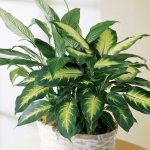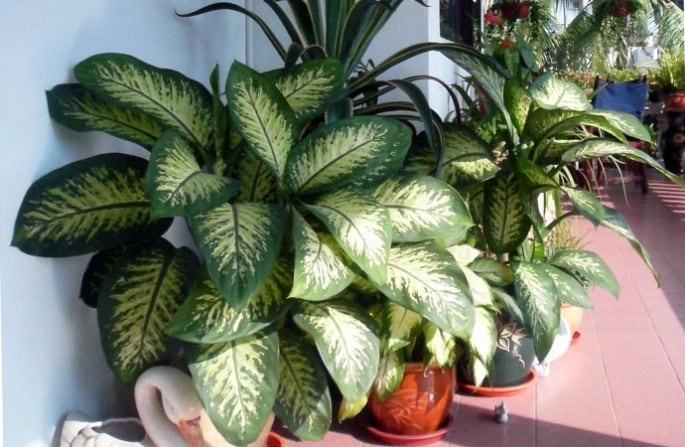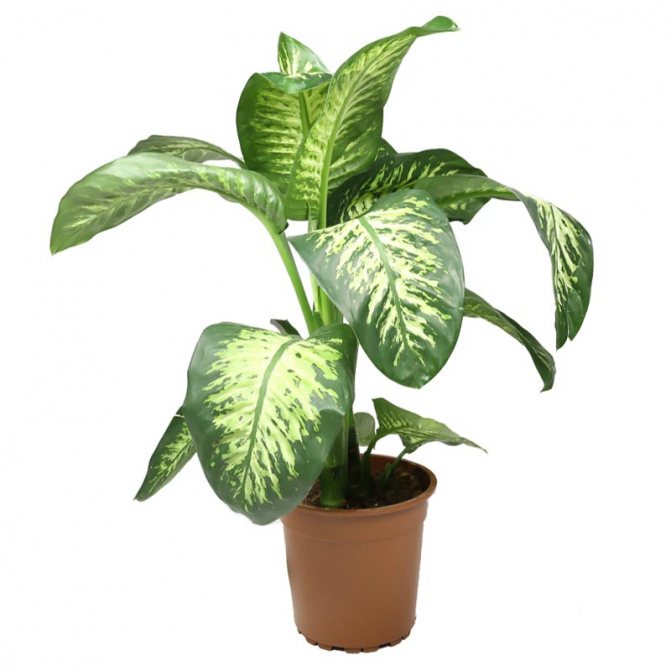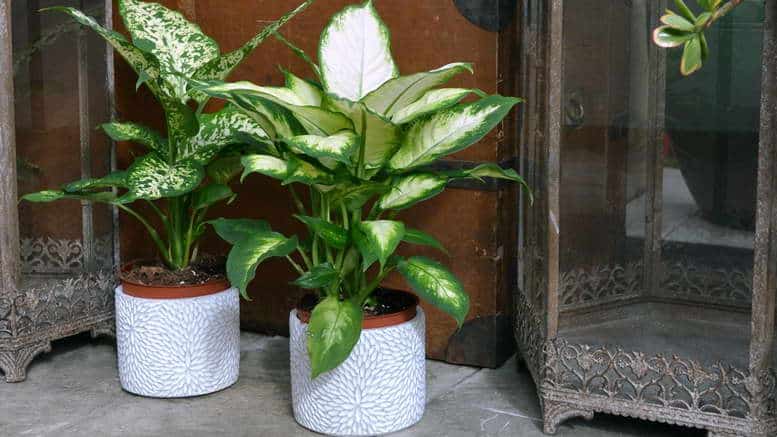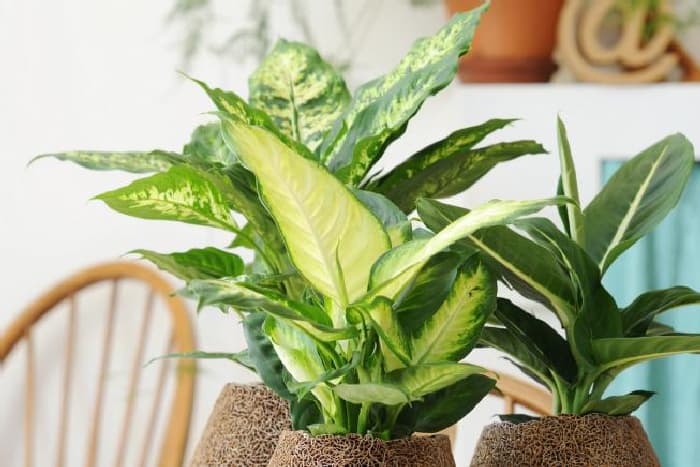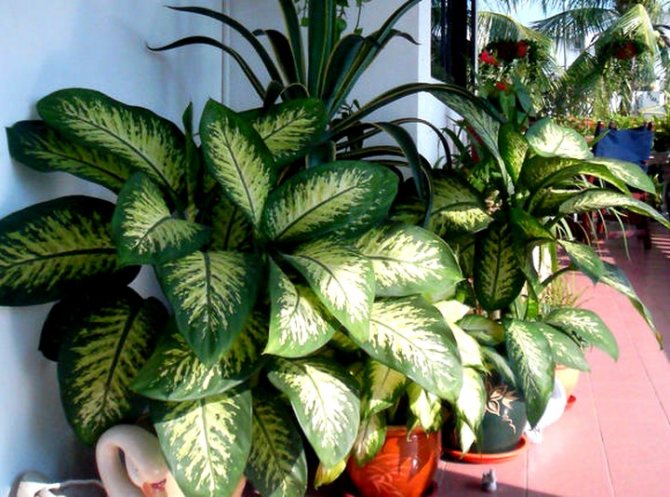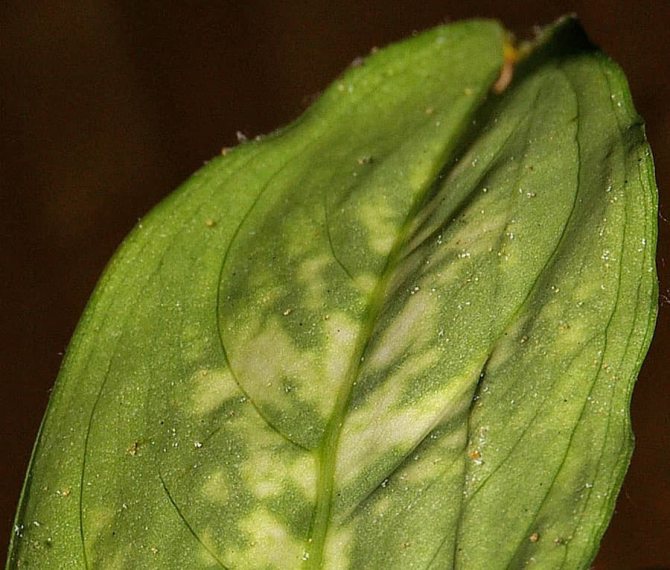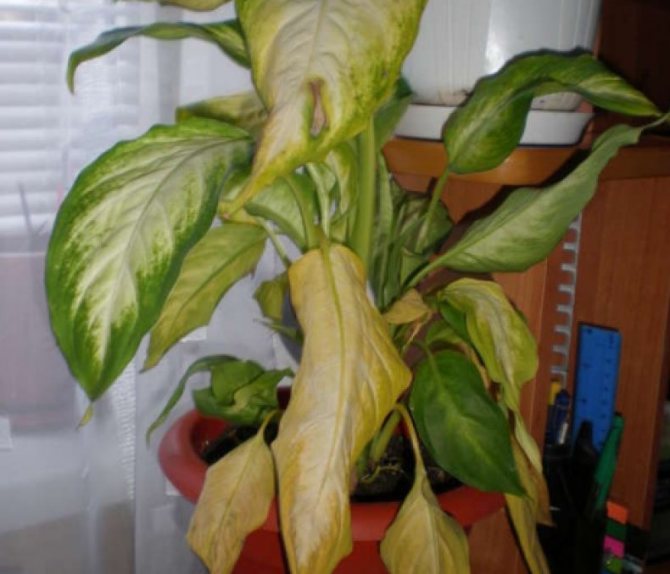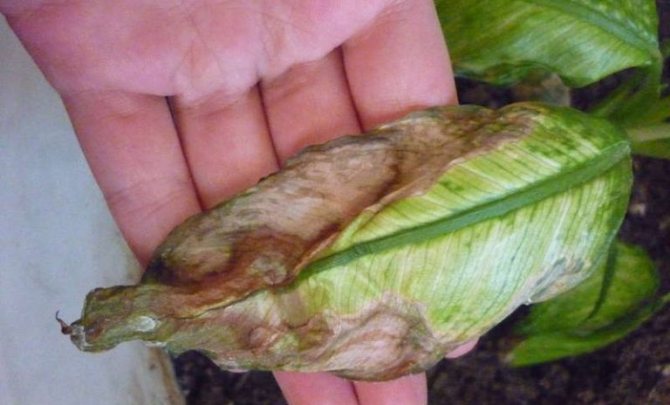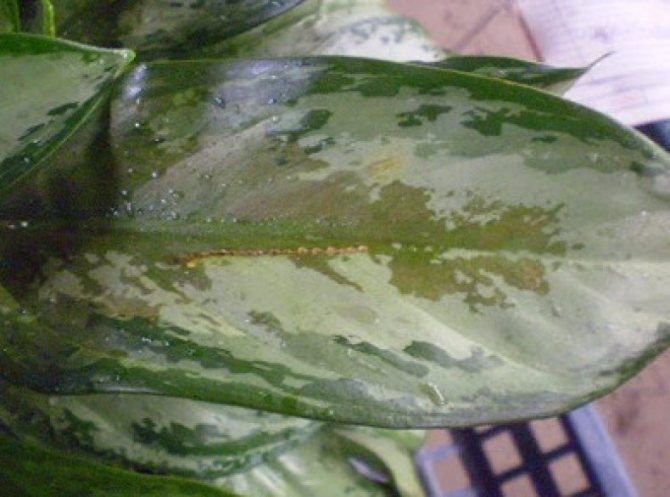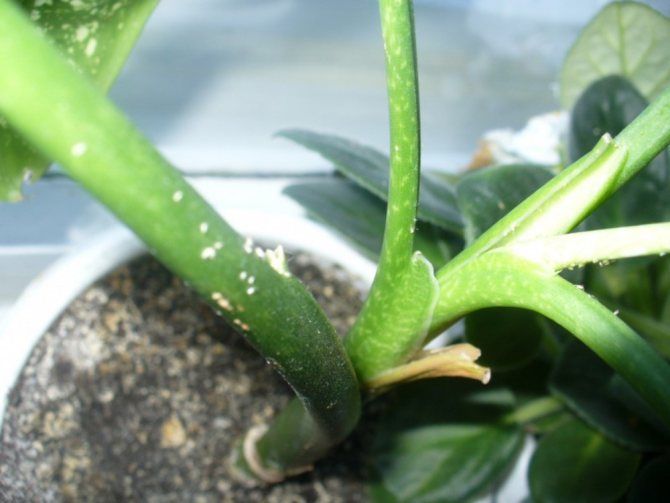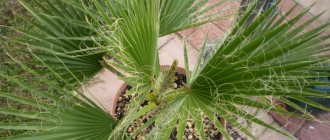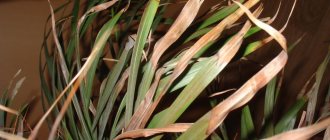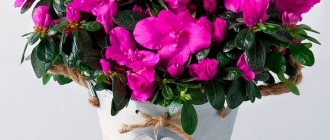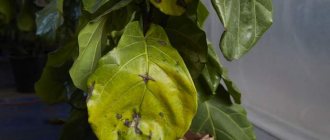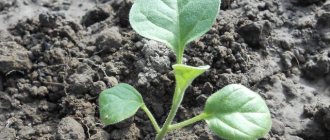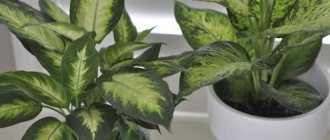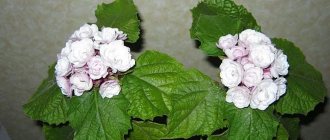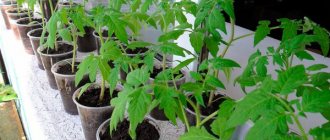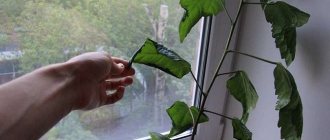Possible causes of leaf diseases
If the problem is not related to natural processes, at the same time other symptoms appear, then the environmental conditions and recent care should be analyzed. In some cases, the plant can die in a short period of time, so treatment should be started as soon as possible.
To establish the cause of the yellowing of the leaves, you should pay attention - a change in color has appeared on young or old leaves, what is the shape of the spots, drying areas are located in the center or along the edges.
Additionally, you can notice cobwebs, rotten places, thinning of the stem, mold, an unpleasant odor from the soil substrate. Symptoms of ill health may appear immediately or a couple of weeks after exposure to a damaging factor.
Noticing yellowing leaves on room dieffenbachia, the cause should be sought in several directions:
- unfavorable indoor climate;
- improper cultivation techniques;
- diseases;
- settlement of pests.
Unsuitable conditions of detention
A microclimate favorable for dieffenbachia implies temperature regime in summer + 20-25 ° C, in winter + 18-19 ° C... There should be no frequent transfers from one room to another, sudden changes in temperature, especially over 10 ° C. Culture adapts to a certain environment, it is difficult to endure changing conditions. Outwardly, the problem may manifest itself as a color change, the appearance of dry areas, general weakness and lethargy of the bush.
Dieffenbachia needs high air humidity, for which it is recommended to regularly spray the indoor flower, place a container with water, wet pebbles or sphagnum moss next to it. With a lack of liquid, the tips of the leaves begin to dry out. If the situation is not corrected, the entire sheet plate will suffer.
Lack or excess of light will change color. Dieffenbachia is a light-loving culture, the brighter and more colorful the color of the aerial part, the better the lighting should be.
On average, daylight hours should be at least 10-12 hours a day... In this case, direct sunlight will leave burns on the sheet plates. Lighting problems become noticeable when the leaves, for some unknown reason, can turn yellow, become covered with uneven dry spots, or wither.
Temperature and humidity
For the life of culture at home, it is necessary to observe the nuances:
- The bush should not be exposed to drafts, temperature extremes, and also be located in places where the temperature is below 12C or within its limits. These conditions cause hypothermia and death of the roots. The process starts with leaflets. At the edges, they begin to turn yellow and fall off.
- Dry and hot air adversely affects the leaves of the crop. The bush should not be near the radiator. If the apartment is hot, the plant must be sprayed with water 2-3 times a day. You can also place the dieffenbachia next to the flowers to moisturize the air.
Control and prevention measures
A healthy plant rarely gets sick in a favorable environment. To protect the bush from yellowing foliage, it is recommended:
- Create an indoor environment close to tropical conditions.
- Do not place the flowerpot in direct sunlight.
- Protect from drafts and sudden changes in temperature, but ventilate the room regularly.
- Observe the modes of lighting, temperature and humidity.
- Provide peace in the winter.
- Transplant in a timely manner.
It is important to know what to do if the leaves of Dieffenbachia are already turning yellow. It is necessary to establish the cause of what is happening and eliminate the damaging factor, strictly follow the recommendations for care. The plant must recover, improve immunity. If only the lower leaves turn yellow in the absence of other signs, nothing needs to be done, since this is a natural aging process of the leaf blades.
The culture is quite hardy and adapts well to indoor cultivation. Yellowing and dryness of foliage indicate mistakes made in creating an optimal microclimate, improperly organized care. In most cases, dieffenbachia can be saved if measures are taken in time. Infectious diseases are not always treatable, therefore, having suspected them, it is necessary to isolate the plant from others.
Watering
To maintain the life of dieffenbachia, it is required to observe the volume of water added to the ground. The plant begins to die with an excess of moisture. The roots and trunk of the plant are fleshy, in which the process of decay begins when waterlogged. You can see the beginning of decay on the lower leaves of the bush - they begin to turn yellow.
Watering the plant correctly:
- After each watering, you must wait for the first layer of soil to dry out.
- For humidification, it is required to add settled water at room temperature. When cold is added, the process of root rotting begins.
- After watering, you need to wait a little, then pour out the remaining water from the pan to avoid damage to the root system.
- Watering is required abundantly, but only after the surface of the earth has dried. You can check it for moisture with your hand or a stick.
An excess of moisture forms a green bloom on the ground, and it becomes mucus.
How does the choice of lighting affect dieffenbachia?
Dieffenbachia is very dependent on the quality of lighting, so this is the first thing to look out for in case of leaf problems. If Dieffenbachia does not receive enough light, then its leaves turn yellow. This can happen if the plant stands in the back of the room, where the light simply does not reach it.
Also, for residents of the lower floors, the windows can be shaded by trees or face the north side. If this is the case, then it is worth thinking about moving the dieffenbachia: either put it closer to the window, if possible, or move it to another room where the lighting is better.
Important! There is another important point when choosing lighting. Since Dieffenbachia is a fairly large plant, it is most often located on the floor, in which case the plant receives side light from the windows.
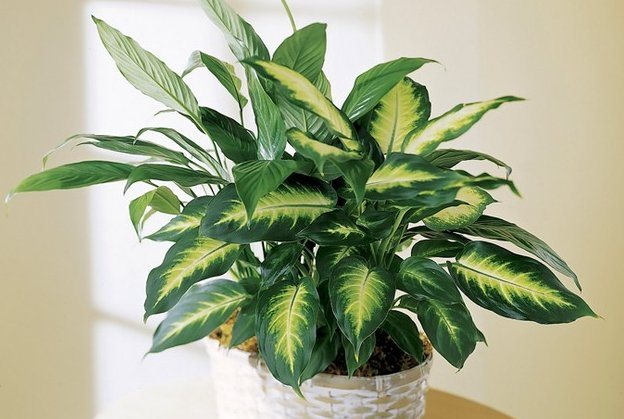
In this case, the top begins to reach for the light, and the plant can lean towards the light source. To avoid this, it is necessary from time to time to turn the plant towards the light with the less illuminated side, so it will develop more evenly and will have a more accurate appearance.
Diseases and pests
Dieffenbachia is often affected by various diseases. Among fungal diseases, the following are more common on this culture:
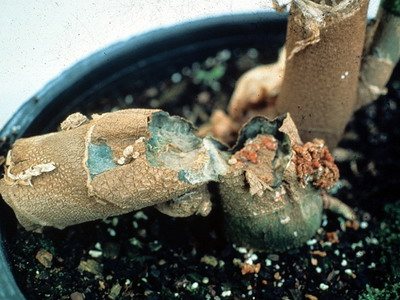

- Anthractosis. The foliage is covered with small orange-yellow spots, which gradually grow and lead to drying and leaf fall. The disease appears if the room is too dry and hot. Spraying with fungicidal preparations will help.
- Spotting. The spots appear starting from the lowest leaves. Spread throughout the crown. The leaf gradually dries up, then dies. All affected leaves are torn off so that the disease does not spread to the rest.
- Fusarium. Dark yellow spots appear on the foliage, then the flower withers and dies. May appear as a result of lack of nutrition and dry soil in the pot.It is necessary to completely replace the substrate, rinse the roots well and treat with special preparations.
- Root rot. It develops due to excessive watering. Fungal colonies first infect the root system, then the entire bush dies. The plant is removed from the planting container, the soil is shaken off and the affected areas of the root system are removed. Then they are planted in a fresh substrate.
- Bacteriosis It appears as clear watery spots along the edges of the leaf plates. For treatment, drugs with a high copper content are used.
Why dieffenbachia fades after transplant
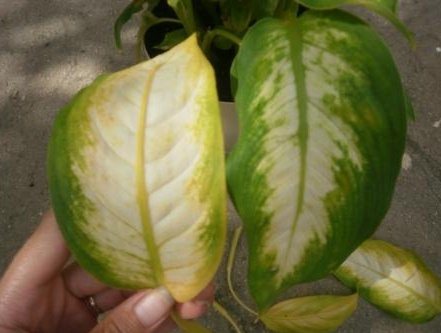

Here dieffenbachia can be harmed in two ways: burn the roots when kept in a solution of potassium permanganate and when transplanting into an unsuitable soil mixture. In the first case, the recommendations of experienced florists are often followed, and there is nothing wrong with this procedure. If you overexposed the plant, then it will recover on its own, you just need to wait. In case of a negative reaction to the soil, it must be replaced. Ready-made earthen mixtures, which are in any flower shop, are best suited.
Planting and caring for dieffenbachia
- Bloom: decorative deciduous plant.
- Lighting: bright diffused light for variegated forms, light partial shade for a view with green leaves.
- Temperature: in summer - 20-30 ˚C, in winter - at least 15 ˚C.
- Watering: plentiful in summer, moderate in winter.
- Air humidity: increased - 65%. Regular spraying of the leaves is recommended.
- Top dressing: once every three weeks during the period of active growth with lime-free mineral solutions at a concentration two times weaker than the recommended one.
- Rest period: from September to March.
- Transfer: from February to May, when the pot becomes small.
- Reproduction: apical and stem cuttings, air layers and, in rare cases, seeds.
- Pests: aphids, thrips, scale insects, spider mites, mealybugs.
- Diseases: bacteriosis, root rot, anthracnose, leaf spot, fusarium, leaf and mosaic bronzing viruses.
- Properties: the sap of the plant is very poisonous and can cause burns.
Read more about growing Dieffenbachia below.
Dieffenbachia leaves turn yellow - what could be the reasons
Why dieffenbachia leaves curl and yellow spots appear depends on various factors. Most often, the problem appears in winter and summer.
In winter, the plant lacks the bright rays of the sun. The leaves become pale, lose contrast and become covered with a yellow tint. Features strongly these symptoms appear when the plant stands on the north side or in a poorly lit place. Sometimes moving the pot to another place helps. However, the owners do not always pay attention to the problem at a harmless stage. The more time passes, the more difficult it is to return a full life to a bush.
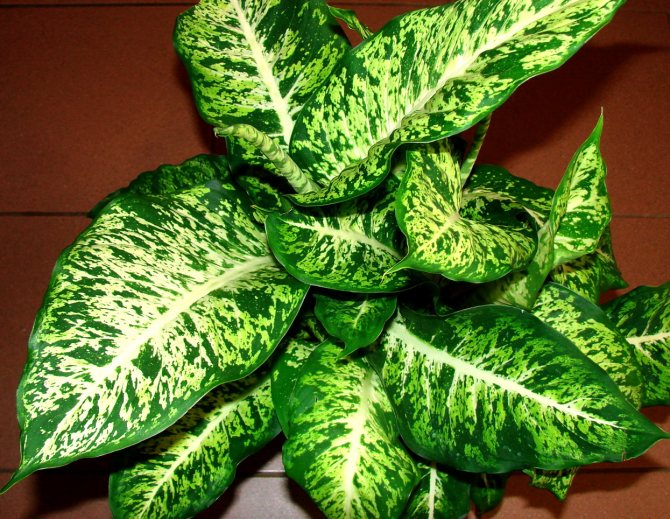

What does a healthy plant look like?
Often the cause is improper watering. Each home flower needs special conditions, so it is impossible to care for everyone in the same way.
In the summertime, the main danger lies in the sultry sunbeams. They provoke burns, due to which yellowing is observed. It is no longer possible to restore the burnt sheet, so it is cut off.
Attention! To avoid problems in the future, you need to monitor the place where the pot stands and shade the plant in time.
There are other problems that the owner of dieffenbachia may face. They will be discussed below.
Diseases
All components of the bush rot and gradually die if the soil is infected, pests or viruses live in the plant.
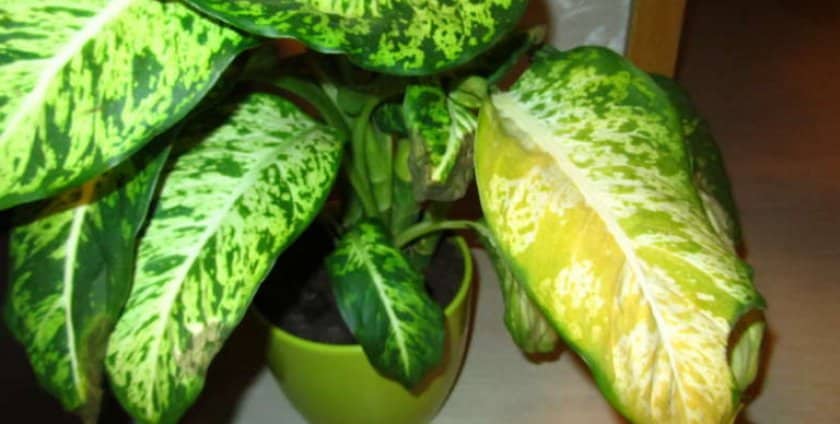

Viral diseases
Viruses pass to plants through the life of pests or from another diseased flower nearby. Common viral diseases:
- Viral mosaic. It is determined by the dark green round spots on the surface of the leaves. Over time, their number increases, and the culture dies.
- Bronze of the leaves.This disease causes wilting of leaves. Round yellow spots form on them.
Plant recovery after the appearance of the virus will not work. Crops must be removed to preserve other crops.
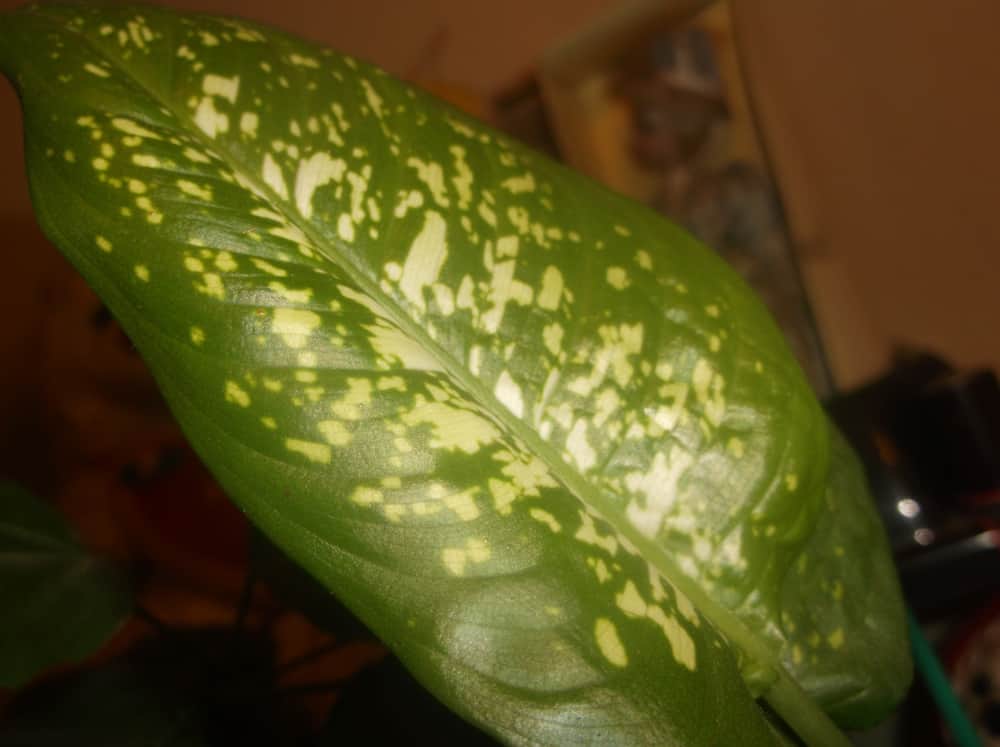

Bacterial diseases
Bacteriosis can be identified by the presence of watery spots on the leaves. If they have clear boundaries, and then turn brown, then the plant dies. It is impossible to restore the bush and it is recommended to get rid of it in order to preserve other crops.
Fungal diseases
Fungal diseases are formed due to viral soil, water and remnants of previous diseased crops. How to identify fungal diseases:
- Brown spots on the leaves that grow larger over time.
- Rotting roots. Gray bloom.
Plant life can be restored only at the first stage of the disease. For this, fungicidal preparations should be used. With the formation of the above signs, the bush must be treated with Vitaros or Fundazol. Process according to instructions.
Errors when feeding dieffenbachia
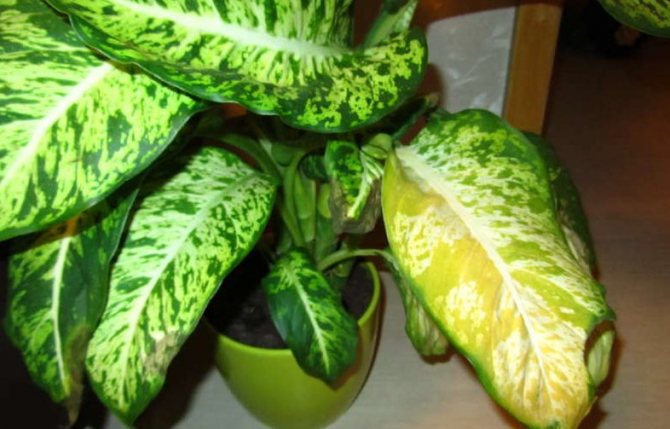

Feeding plants is, of course, necessary, but if you overdo it with this, then the consequences cannot be avoided. This is another reason why dieffenbachia leaves dry out. If you notice this after the next feeding, then the plant urgently needs to be transplanted into a new soil mixture. There is no other way to get rid of the excess fertilizer.
Important! Do not try to remove excess fertilizer by additional watering! This will lead to stagnation of water and, as a result, root rot.
Although dieffenbachia does not belong to whimsical plants, it is best to use special soil for it. Please note that store plants are planted in a special transport soil, which is poorly suited for home conditions. Therefore, after purchase, it is recommended to transplant the flower into new, high-quality soil.
Growing conditions dieffenbachia - briefly about everything
Dieffenbachia has a thick, succulent stem, more like a tree trunk, which bears a cap of large variegated leaves. The growth point is at the top of the shoot, but some species are able to bush. At the same time, dormant buds awaken at the base of the dieffenbachia shoot, and sometimes located higher.
The plant requires the following growing conditions:
Lighting. Shading in summer, good lighting in winter. In a too dark place, the leaves become smaller, and the plant loses its decorative appeal. Dieffenbachia will grow well under the protection of a tulle curtain near an east or west window.
Watering dieffenbachia. Abundant from spring to autumn, moderate in winter. The soil is kept slightly moist at all times, but should not be too moist. When watering with too hard water, the tips of the leaves turn brown.
Reproduction of dieffenbachia. Trunk cuttings of 5-7 cm, which are rooted with soil heating at 30 ° C. Some forms produce daughter shoots, which are cut and rooted. To rejuvenate the plant, the top with part of the trunk is cut off, it takes root well.
Air humidity. Dieffenbachia loves very humid air; regular spraying and washing of the leaves is required. Before spraying, make sure that the room is warm and does not "blow" from anywhere, otherwise you can harm the plant. If the room is about 18 ° C, it is better not to spray, but just periodically wipe it with a damp sponge.
Dieffenbachia transplant. Annually in spring - better at the end of April. The soil is a mixture of turf (4 parts), leaf (1 part), peat (1 part) and sand (1 part). Dieffenbachia are fast-growing plants, but due to the fact that the plants grow quite large, transplanting is difficult, in this case it is advisable to replace the top layer of the earth with very nutritious soil. It would be nice to add a little charcoal to the soil.
Dieffenbachia feeding. In the period from May to August, top dressing with complex fertilizer every two weeks. They do not feed in autumn and winter. With a lack of nutrients, the trunk from below is exposed much faster.
Undercutting.It does not need, when pulling the plant, the top can be pinned.
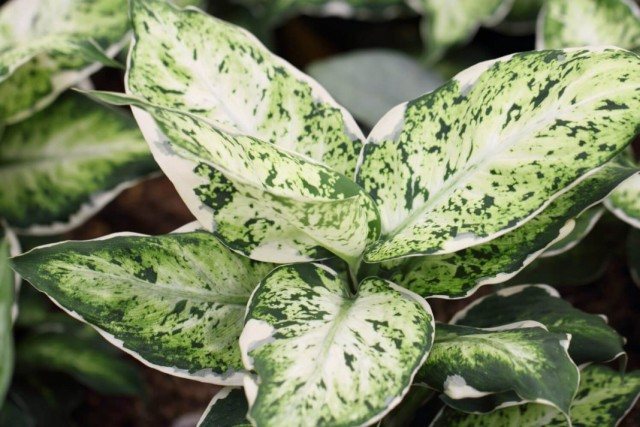

Variegated dieffenbachia (Dieffenbachia). <>
Types and varieties of dieffenbachia
The most common species in culture are Dieffenbachia maculata and Dieffenbachia variegated, or painted (Dieffenbachia picta) - plants with a large succulent stem and elongated oval leaf plates with obvious venation, reaching 12 cm in width and up to half a meter in length. Their bright green leaves are dotted with white spots and stripes. They differ from each other in that variegated dieffenbachia grows up to two meters in height, and spotted dieffenbachia does not exceed a meter, but its leaves are slightly larger in size and they are more pointed at the top. It was the spotted dieffenbachia that became the basis for most varieties and hybrids bred by breeders. Here are some of the most popular varieties of Dieffenbachia spotted in the culture:
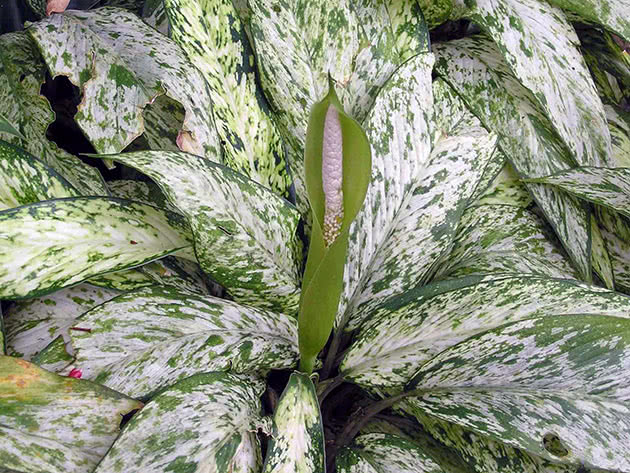

- variety "Vesuvio" - a graceful medium-sized plant with narrow, delicate white leaves and green specks on white petioles;
- Dieffenbachia "Camilla" is one of the most hardy bushy varieties, which is why it has earned popularity among amateurs. Lanceolate creamy white leaves are surrounded by a light green rim. Young leaves are greenish;
- Dieffenbachia "Compact" is a neat dense bush with green leaves with light specks along the central vein.
Dieffenbachia leopoldii
A low-growing plant native to Costa Rica with a short and thick stem, pale green short petioles with purple spots and dark green elliptical leaves up to 35 cm long with a pronounced white central vein.
Dieffenbachia adorable, or pleasant (Dieffenbachia amoena)
Lovers of flowers like it for its unpretentiousness and excellent adaptability to home conditions, since it tolerates dry air and the proximity of heating devices better than other species. In addition, its decorative qualities are beyond any criticism: height up to one and a half meters, large dark green oval leaves up to 60 cm long with white stripes along all veins.
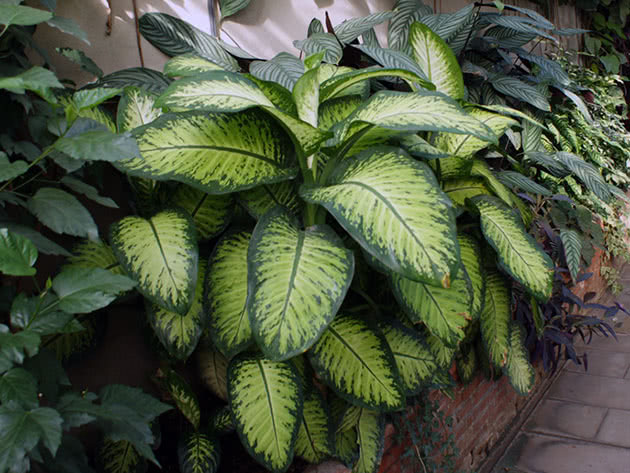

Dieffenbachia seguina
Which amateurs often confuse with spotted dieffenbachia, has wider - up to 16 cm - leaves with fewer lateral veins than that of spotted dieffenbachia. This species also gave many varieties and hybrids, for example, "Tropic Snow" - never out of fashion cultivar with the correct pattern on the leaves formed by yellow spots, while the central vein and edges of the leaves remain dark green.
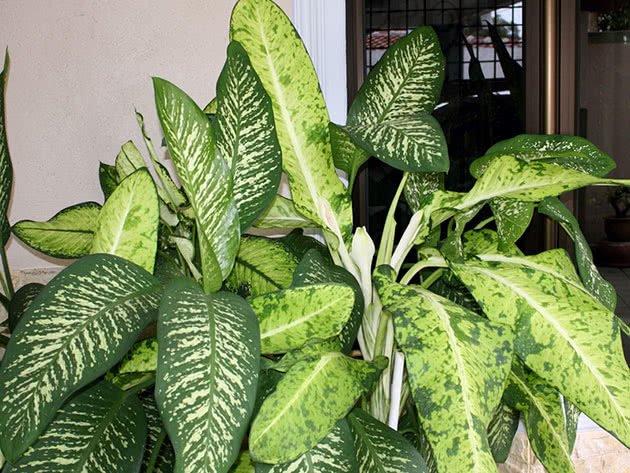

Dieffenbachia oerstedii
View with monochromatic green leaves of a cordate or pointed shape with a distinct light central vein. The leaves are 30-35 cm long. The most famous hybrid of this species is "Green Magic", a dense small bush with unusual color leaves: they are dark bluish-green with a white central vein. There is a form with small light specks along the leaf blade.
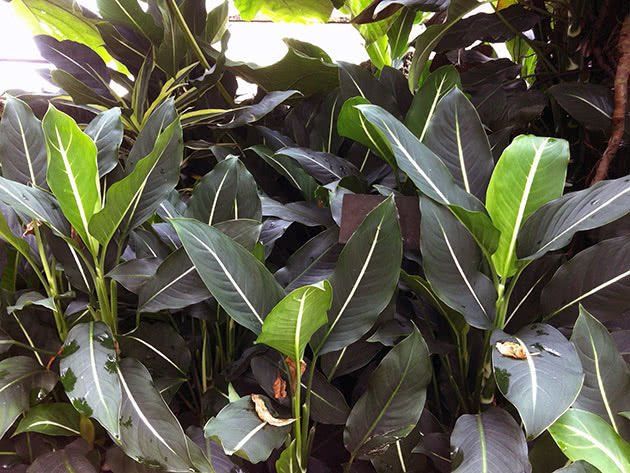

Dieffenbachia magnifica
The appearance is light green with white dots along the leaves and petioles.
- Photo of arrowroot bicolor
Dieffenbachia macrophylla
The only species with monochromatic green leaves and veins, the shape of the leaf plate is ovoid, the median vein is thickened. This species grows in height up to one meter.
Dieffenbachia bowmannii
The species with the largest leaves among Dieffenbachia up to 70 cm long is dark green in color with small light specks.
Dieffenbachia bausei
It has yellowish-green leaves up to 35 cm long with a marble pattern of dark green and white spots.

